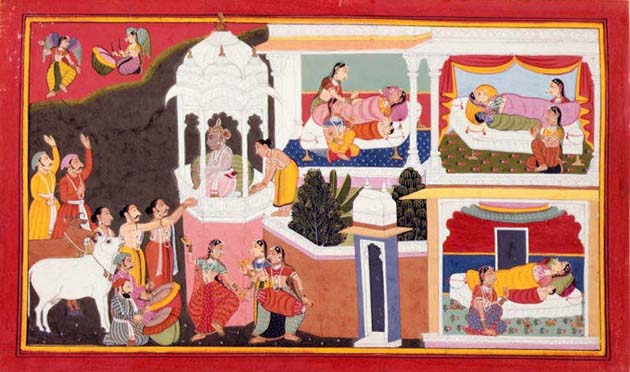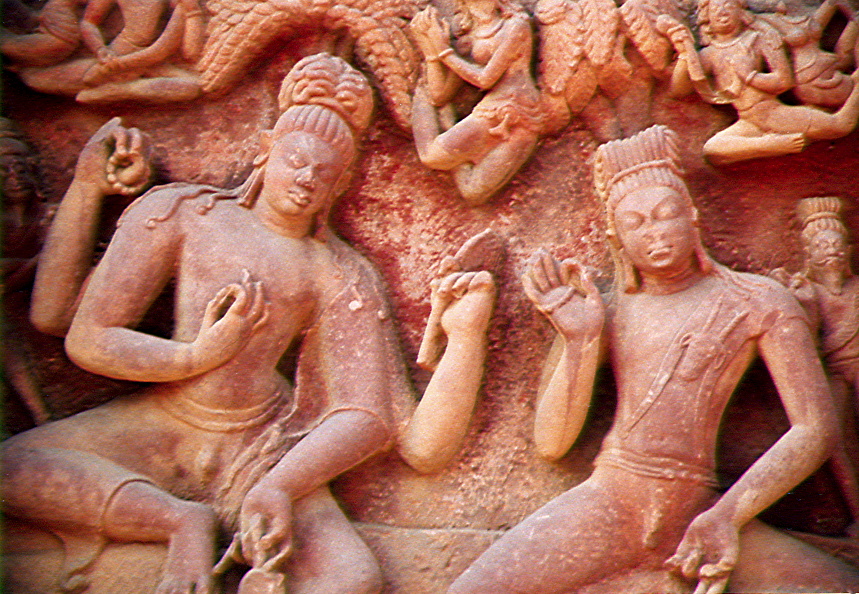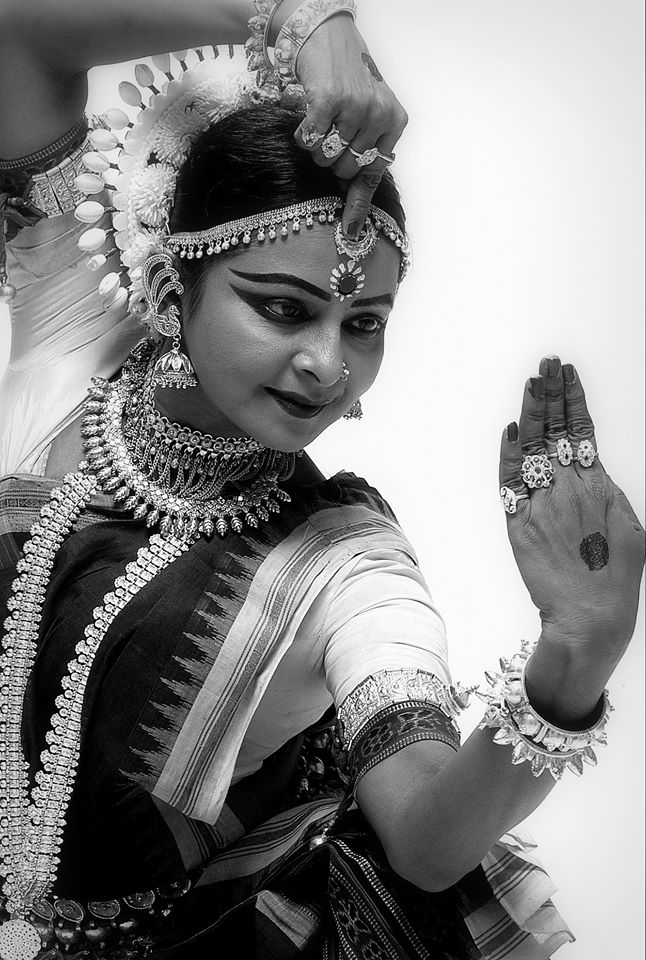|
Ahalya
In Hinduism, Ahalya (, IAST: Ahalyā) also spelt as Ahilya, is the wife of the sage Gautama Maharishi. Many Hindu scriptures describe her legend of seduction by the king of the gods Indra, her husband's curse for her infidelity, and her liberation from the curse by the god Rama. Created by the god Brahma as the most beautiful woman, Ahalya was married to the much older Gautama. In the earliest full narrative, when Indra comes disguised as her husband, Ahalya sees through his disguise but nevertheless accepts his advances. Later sources often absolve her of all guilt, describing how she falls prey to Indra's trickery. In all narratives, Ahalya and Indra are cursed by Gautama. The curse varies from text to text, but almost all versions describe Rama as the eventual agent of her liberation and redemption. Although early texts describe how Ahalya must atone by undergoing severe penance while remaining invisible to the world and how she is purified by offering Rama hospitality, in ... [...More Info...] [...Related Items...] OR: [Wikipedia] [Google] [Baidu] |
Panchakanya
The Panchakanya () is a group of five iconic women of the Hindu epics, extolled in a hymn and whose names are believed to dispel sin when recited. They are Ahalya, Draupadi, Kunti, Tara (Ramayana), Tara, and Mandodari. While Draupadi and Kunti are from the ''Mahabharata'',Chattopadhyaya pp. 13–4 Ahalya, Tara, and Mandodari are from the ''Ramayana''. The Panchakanya are regarded to be ideal women who exemplify perfect wives in Hinduism. Etymology Panchakanya literally means five ''kanya''s. ''Kanya'' may be translated as girl, daughter, maiden, or virgin. Hymn A well-known Sanskrit hymn that defines the Panchakanya runs as: ''Sanskrit transliteration'' English translation Ahalya, Draupadi, Sita, Tara and Mandodari One should forever remember the panchakanya who are the destroyers of great sins A variant from the of Brahma Purana, Brahma purana 3.7.229 by Vyasa replaces Sita with Kunti: ''Sanskrit transliteration'' Differences are underlined. Practising Hindus, es ... [...More Info...] [...Related Items...] OR: [Wikipedia] [Google] [Baidu] |
Gautama Maharishi
Gautama (, ), was a sage in Hinduism and son of Brahmin sage Dirghatamas who is also mentioned in Jainism and Buddhism. Gautama is mentioned in the Yajurveda, Ramayana, and Ganesha Purana, Gaṇeśa Pūrana and is known for cursing his wife Ahalya, Ahalyā. Another important story related to Gautama is about the creation of river Godavari River, Godavari, which is also known as Gautami. Children According to the Ramayana, Gautama's eldest son with Ahalya is Shatananda. But according to the Adi Parva of Mahabharata, he had two sons named Sharadvana and Cirakari. Sharadvana was also known as Gautama, hence his children Kripa and Kripi were called Gautama and Gautami respectively. A daughter of Gautama is referred too, but her name is never disclosed in the epic. In the Sabha Parva, he is described to beget many children through Aushinara (daughter of Ushinara), amongst whom the eldest in Kakshivata. Gautama and Aushinara's wedding takes place at Magadha, the kingdom of Jarasandha. ... [...More Info...] [...Related Items...] OR: [Wikipedia] [Google] [Baidu] |
Shatananda
Shatananda (Sanskrit: शतानंद) was a Vedic sage and the chief priest at the court of the King Janaka in ancient Mithila. In the Valmiki Ramayana he is mentioned as the eldest son of the sage Maharshi Gautama and Devi Ahalya. Etymology Shatananda is a compound Sanskrit word having two terms ''Shata'' and ''Ananda''. The meaning of the first term ''Shata'' is hundred and good. And the meaning of the second term ''Ananda'' is who delights. Thus the compound meaning of the word ''Shatananda'' is to give somebody hundred times good and great pleasure. Early life According to Ramayana, Shatananda was born in the region of ancient Mithila Kingdom. His father was Maharshi Gautama and mother was Ahalya. He was the eldest son of the couple Maharshi Gautama and Ahalya. Description In Ramayana, Shatananda was a member of the court of King Janaka. He is mentioned as the ''Kulguru'' of the King Janaka. He was the chief priest and religious advisor at the court of King Janak ... [...More Info...] [...Related Items...] OR: [Wikipedia] [Google] [Baidu] |
Indra
Indra (; ) is the Hindu god of weather, considered the king of the Deva (Hinduism), Devas and Svarga in Hinduism. He is associated with the sky, lightning, weather, thunder, storms, rains, river flows, and war. [3 volumes] Indra is the most frequently mentioned deity in the ''Rigveda''. He is celebrated for his powers based on his status as a god of order, and as the one who killed the great evil, an Asura (Hinduism), asura named Vritra, who obstructed human prosperity and happiness. Indra destroys Vritra and his "deceiving forces", and thereby brings rain and sunshine as the saviour of mankind. Indra's significance diminishes in the post-Vedic Indian literature, but he still plays an important role in various mythological events. He is depicted as a powerful hero. According to the ''Vishnu Purana'', Indra is the title borne by the king of the gods, which changes every Manvantara – a cyclic period of time in Hindu cosmology. Each Manvantara has its own Indra and the In ... [...More Info...] [...Related Items...] OR: [Wikipedia] [Google] [Baidu] |
Raja Ravi Varma
Raja Ravi Varma () (29 April 1848 – 2 October 1906) was an Indian painter and artist. His works are one of the best examples of the fusion of European academic art with a purely Indian sensibility and iconography. Especially, he was notable for making affordable Lithography, lithographs of his paintings available to the public, which greatly enhanced his reach and influence as a painter and public figure. His lithographs increased the involvement of common people with fine arts and defined artistic tastes among the common people. Furthermore, his religious depictions of Hindu deities and works from Indian epic poetry and Puranas have received profound acclaim. He was part of the royal family of erstwhile Parappanad, Malappuram district. Raja Ravi Varma was closely related to the royal family of Travancore of present-day Kerala state in India. Later in his life, two of his granddaughters were adopted into the royal family. Personal life Raja Ravi Varma was born M. R. Ry. Rav ... [...More Info...] [...Related Items...] OR: [Wikipedia] [Google] [Baidu] |
Vishnudharmottara Purana
The Vishnudharmottara Purana (or the ''Vishnudharmottara'') is a Hindu Sanskrit text in the '' Upapuranas'' genre. Like the ''Mahapuranas'', it is also encyclopedic covering a wide range of topics in the traditions of Hinduism. It is included in the list of eighteen Upapuranas given in the Brihaddharma Purana (1.25.23-26). History It is most celebrated for '' Chitrasutras'' constituting chapters 35–43 of the third ''khanda'' (book). This much cited part of the text dates from the Gupta period of Indian history. The ''Chitrasutra'' section of the ''Vishnudharmottara Purana'' has been discovered in manuscripts all over India and Nepal in Devanagari, Sharada, Bengali, and Newari scripts. The compilation that has survived into the modern age was likely complete by the 5th or 6th-century CE according to David Pingree. It is one of the oldest known complete Sanskrit treatises on painting arts in India. Content The ''Vishnudharmottara Purana'' is a Vaishnava-tradition text. ... [...More Info...] [...Related Items...] OR: [Wikipedia] [Google] [Baidu] |
Gujarat
Gujarat () is a States of India, state along the Western India, western coast of India. Its coastline of about is the longest in the country, most of which lies on the Kathiawar peninsula. Gujarat is the List of states and union territories of India by area, fifth-largest Indian state by area, covering some ; and the List of states and union territories of India by population, ninth-most populous state, with a population of 60.4 million in 2011. It is bordered by Rajasthan to the northeast, Dadra and Nagar Haveli and Daman and Diu to the south, Maharashtra to the southeast, Madhya Pradesh to the east, and the Arabian Sea and the Pakistani province of Sindh to the west. Gujarat's capital city is Gandhinagar, while its largest city is Ahmedabad. The Gujarati people, Gujaratis are indigenous to the state and their language, Gujarati language, Gujarati, is the state's official language. The state List of Indus Valley civilisation sites#List of Indus Valley sites discovered, ... [...More Info...] [...Related Items...] OR: [Wikipedia] [Google] [Baidu] |
Balakanda
''Bala Kanda'' (; IAST: ', ) is the first Book of the Valmiki ''Ramayana.'' The ''Bala Kanda,'' in partif not in its entiretyis generally regarded as an interpolation to the original epic.'''' Structure The book consists of seventy-six ''sargas'' (sometimes translated as ''chapters'' or "cantos") of Sanskrit verse. Synopsis The Bāla Kāṇḍa begins with the sage Vālmīki asking Nārada if there is a righteous man still left in the world, to which Nārada replies that such a man is Rāma. After seeing two birds being shot, Vālmīki creates a new form of meter called ''śloka'', and then is granted the ability to compose an epic poem about Rāma. He teaches his poem to the boys Lava and Kuśa, who recite it throughout the land and eventually at the court of king Rāma, which then begins the main narrative. The king of Kosala, Daśaratha, lives in Ayodhyā, a utopian city, however he has no son. He and his court resolve to bring the sage R̥śyaśr̥ṅga in order to grant ... [...More Info...] [...Related Items...] OR: [Wikipedia] [Google] [Baidu] |
Brahma Purana
The ''Brahma Purana'' ( or ; ) is one of the eighteen major Puranas collections of Hindu texts in Sanskrit. It is listed as the first Mahapurana in all anthologies, and is therefore also called ''Adi Purana''. Another title for this text is ''Saura Purana'', because it includes many chapters related to Surya, the sun god. The ''Brahma Purana'' is a compilation of geographical Mahatmya (travel guides) and sections on diverse topics. History The Brahma Purana holds an established place as a Mahapurana, however, scholars debate whether the current version of the Brahma Purana is the original Mahapurana or a later Upapurana (secondary Purana). R. C. Hazra through textual analysis, argues that the current version is not the original Brahma Purana but a later compilation that shared the same name. Hazra's conclusion stems from his examination of quotations made by classical Nibandha writers—who frequently quoted verses of the Brahma Purana which cannot be found in the present text ... [...More Info...] [...Related Items...] OR: [Wikipedia] [Google] [Baidu] |
Urvashi
Urvashi (, ) is the most prominent apsara mentioned in the Hindu scriptures like the ''Vedas'', the epics ''Ramayana'' and ''Mahabharata'', as well as the ''Puranas''. She is regarded as the most beautiful of all the apsaras, and an expert dancer. Urvashi has been featured in many mythological events. She emerged out of the thigh of sage Narayana and occupies a special place in the court of Indra, the king of the gods and ruler of svarga. She is famous for her marriage with Pururavas, the first king of the legendary ''Chandravamsha'', whom she later abandoned. She also plays a significant part in the birth of Vashishtha and Agastya, two of the most revered sages in Hinduism. Urvashi's story has been an inspiration for various arts, performances and literature. The poet Kalidasa (fl. 4th -5th century CE) has adapted Urvashi and Pururavas as the main characters in his play Vikramorvashiyam. Etymology The Sanskrit name ''"Urvaśī"'' is derived from roots''uru'' and ''aś''. ... [...More Info...] [...Related Items...] OR: [Wikipedia] [Google] [Baidu] |
Odissi Dance
''Odissi'' (''ଓଡ଼ିଶୀ'') also referred to as ''Orissi'' in old literature, oldest surviving classical dance of India, is a major ancient Indian classical dance that originated in the Hindu temple, temples of Odisha – an eastern coastal state of India.Odissi ''Encyclopædia Britannica'' (2013) Odissi, in its history, was performed predominantly by women, and expressed religious stories and spiritual ideas, particularly of Vaishnavism through songs written and composed according to the ''ragas'' & ''talas'' of Odissi music by ancient poets of the state. Odissi performances have also expressed ideas of other traditions such as those related to Hindu deities Shiva and Surya, as well as Hindu goddesses (Shaktism)., Quote: "There are other te ... [...More Info...] [...Related Items...] OR: [Wikipedia] [Google] [Baidu] |








